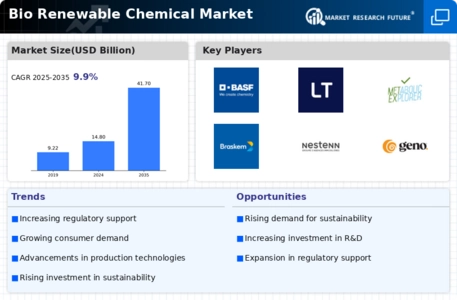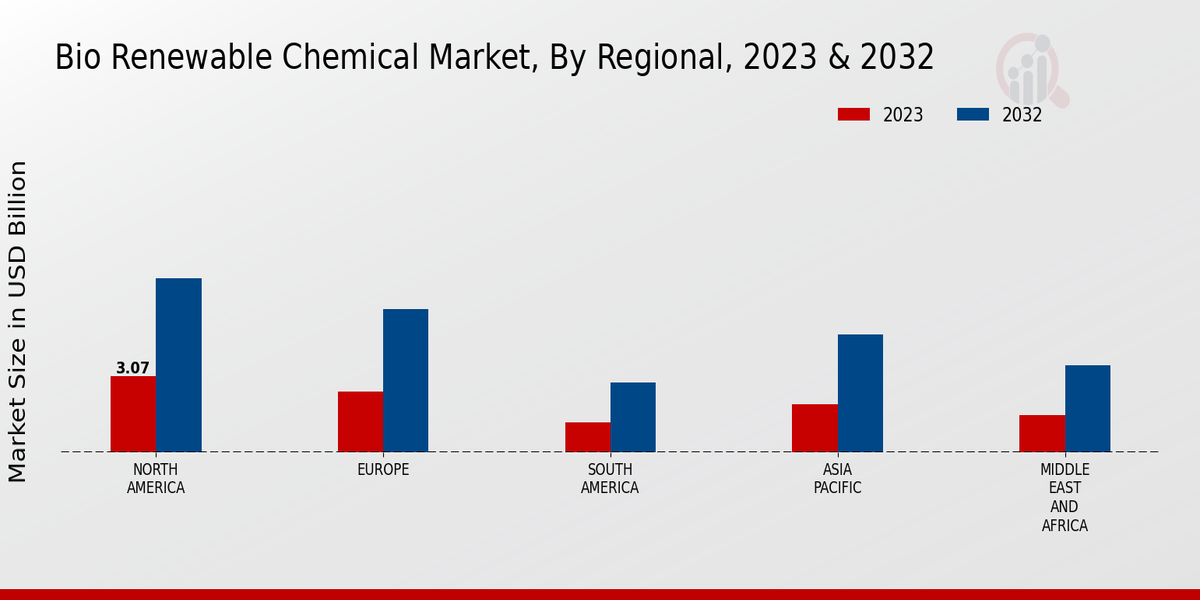Market Growth Projections
The Global Bio Renewable Chemical Market Industry is poised for substantial growth, with projections indicating a market size of 14.8 USD Billion in 2024 and an anticipated increase to 41.7 USD Billion by 2035. This growth trajectory suggests a compound annual growth rate (CAGR) of 9.88% from 2025 to 2035. Such figures reflect the increasing adoption of bio-based chemicals across various industries, driven by sustainability initiatives and consumer demand for greener alternatives. The market's expansion is likely to be supported by ongoing technological advancements and favorable government policies, positioning bio renewable chemicals as a key component of future industrial practices.
Growing Industrial Applications
The Global Bio Renewable Chemical Market Industry is witnessing an expansion in industrial applications, as various sectors recognize the benefits of bio-based chemicals. Industries such as automotive, packaging, and textiles are increasingly incorporating renewable chemicals into their processes, driven by the need for sustainable alternatives. For example, bio-based plastics are gaining traction in packaging due to their lower environmental impact compared to conventional plastics. This diversification of applications not only broadens the market scope but also enhances the overall demand for bio renewable chemicals, contributing to the industry's projected growth trajectory.
Consumer Awareness and Education
Consumer awareness and education are crucial drivers of the Global Bio Renewable Chemical Market Industry. As individuals become more informed about the environmental impacts of their choices, there is a growing preference for products made from renewable resources. Educational campaigns and initiatives by environmental organizations play a significant role in promoting the benefits of bio-based chemicals. This increased awareness is likely to influence purchasing decisions, leading to higher demand for sustainable products. Consequently, businesses are responding by expanding their portfolios to include bio renewable options, further stimulating market growth.
Government Support and Regulations
Government initiatives and regulations play a pivotal role in shaping the Global Bio Renewable Chemical Market Industry. Various countries are implementing policies that encourage the production and use of bio-based chemicals, often through subsidies, tax incentives, and grants. For instance, the European Union has established stringent regulations aimed at reducing carbon emissions, which indirectly boosts the demand for renewable chemicals. Such supportive measures are likely to propel the market forward, with projections indicating a growth to 41.7 USD Billion by 2035. This regulatory landscape fosters innovation and investment in bio renewable technologies, creating a conducive environment for market expansion.
Rising Demand for Sustainable Products
The Global Bio Renewable Chemical Market Industry experiences a surge in demand for sustainable products as consumers increasingly prioritize environmentally friendly options. This shift is driven by heightened awareness of climate change and the environmental impact of traditional chemicals. As a result, companies are investing in bio-based alternatives, which are perceived as safer and more sustainable. The market is projected to reach 14.8 USD Billion in 2024, reflecting a growing consumer preference for renewable chemicals. This trend not only supports environmental goals but also aligns with regulatory frameworks promoting sustainability, thereby enhancing the market's growth potential.
Technological Advancements in Production
Technological advancements are transforming the Global Bio Renewable Chemical Market Industry by enhancing production efficiency and reducing costs. Innovations in biotechnology, such as synthetic biology and metabolic engineering, enable the development of bio-based chemicals from renewable resources. These technologies not only improve yield but also minimize waste, making the production process more sustainable. As a result, companies are increasingly adopting these advanced methods, which could lead to a compound annual growth rate (CAGR) of 9.88% from 2025 to 2035. This trend indicates a robust future for bio renewable chemicals as technology continues to evolve and drive market growth.











